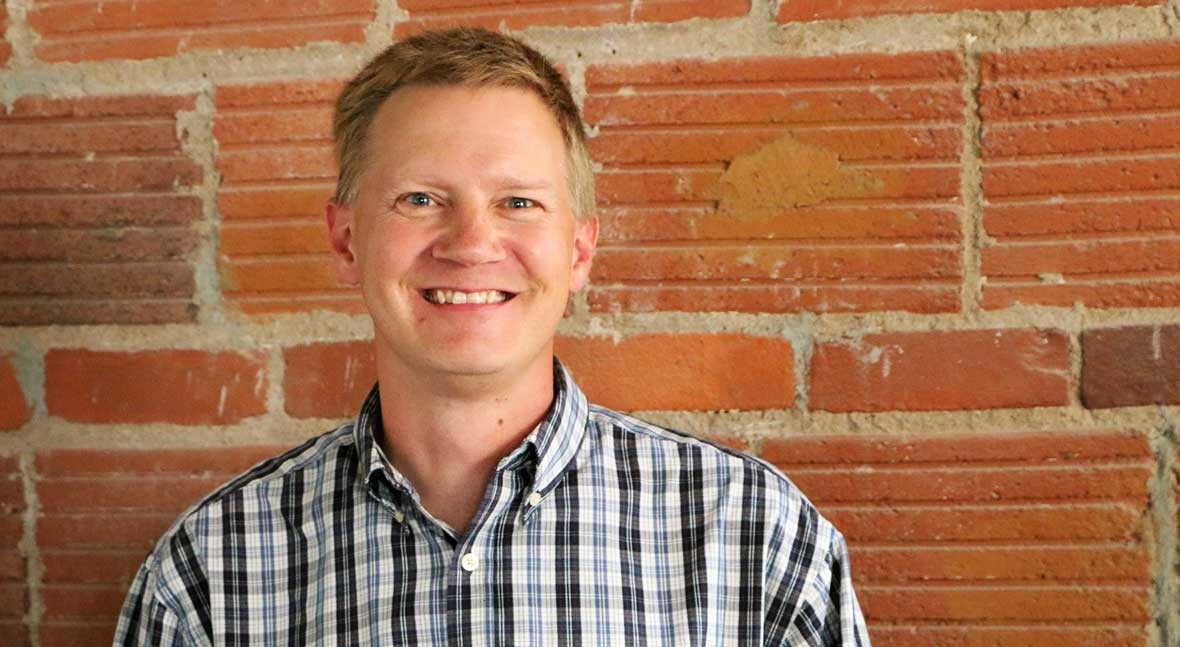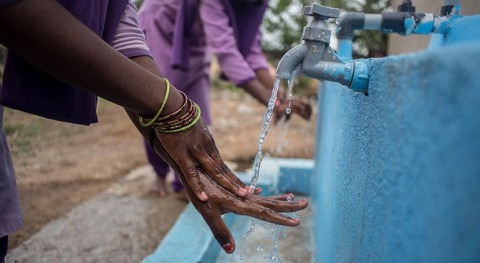Water.org has been working to provide access to water and sanitation to the world for more than 25 years. Now more than ever, their work is critical to curb disease spread and build resiliency for the future.
The COVID-19 pandemic highlights the need to accelerate access to safe water and sanitation for all, to reduce the impact of this and future pandemics. The global nonprofit Water.org helps people get access to safe water and sanitation through affordable financing, such as small loans. They provide life-changing resources, bringing hope, health, and a bright future to families. We interview Richard Thorsten, Chief Impact Officer, who leads the team responsible for working with financial institutions, water and sanitation enterprises, and other sector leaders, to learn about the approach they use to empower millions of people in need with access to safe water and sanitation.
Question: What is your assessment of the progress made worldwide regarding SDG 6 on access to water and sanitation?
Answer: The SDGs were designed to be ambitious and push the global community to take unprecedented actions. We raised the bar significantly – what would have been considered “A” achievement under the Millennium Development Goals would be considered a “C” under the new standards. In 2018, the United Nations conducted an assessment of progress towards SDG 6 targets. Given the intentional ambition of these goals, their findings were not a huge surprise – the world is not on track. Billions of people still lack safe water, sanitation, and handwashing facilities: 844 million lack basic water services, 1.2 billion lack safely managed water, 5.4 billion lack access to safely managed sanitation and 892 million still practice open defecation. Only 27 percent of the population in least-developed countries has access to soap and water for handwashing on-premises – a shortcoming with consequences that have never been so widely apparent as they are now amidst our global struggle against the COVID-19 pandemic.
The water and sanitation community talks extensively about innovative finance that blends donor contributions with commercial capital
There is a glass-half-full perspective to the facts, however. In the period between 2016 till March 31, 2020, 25,349,376 people accessed household water and/or sanitation through the efforts of Water.org and its finance partners on the ground across 13 countries. Since 2016, more organizations have seen the data and embraced similar financing approaches to water and sanitation access in their solutions to the challenge. Moreover, the water and sanitation community now talks extensively about innovative finance that blends donor contributions with commercial capital as part of the solution, something that was rarely happening before. We’re getting smarter as a group and we’re working more collaboratively towards these ambitious goals. We see the numbers are catching up to and reflecting these critical evolutions, and the coming decade will see accelerated impact at greater scale.
Q: How did Water.org decide to concentrate efforts on small loans for water and sanitation?
A: We observed that people, despite abject poverty, were making huge financial sacrifices to try and change their water situation, turning to informal credit markets—loan sharks—to do so. We learned that people earning as little as $1.25 a day were willing to access financing for water and sanitation if they could overcome the obstacles that stood in their path. We asked: what if we could facilitate small, affordable loans for water and sanitation access? Microfinance was enabling poor people to generate income by creating their own micro businesses. Could we add microfinance to the tools we had available to provide the poor access to safe water and sanitation? The answer was yes.
Our organization, Water.org, now works with microfinance providers to extend affordable financing solutions for safe water and sanitation to the poor. We use our capital to offset start-up costs and provide technical assistance to help microfinance institutions build water-based loan portfolios. Our microfinance partners leverage financing from banks and capital markets so that they can disburse loans to their clients, who include both individuals and small communities. Their clients then hire contractors and use retailers to improve their own water and sanitation.
Water.org works with microfinance providers to extend affordable financing solutions for safe water and sanitation to the poor
Wherever we can empower people to solve their own water and sanitation problems, they can break the poverty cycle. People are not just investing in clean water and toilets; they are buying back time so that they can spend it caring for family, going to school, and earning more money. This latter point is significant: Only 53 percent of WaterCredit borrowers in India were earning $47 per month or more before they took out a loan, but after financing their own water solutions, 97 percent of borrowers were achieving this level of income.

Washing at the river. Haiti. By Water.org
Q: You use a market-driven, financial approach to help change the lives of people in need, given the right utility infrastructure, economic demographics, and political environment. Could you explain further the conditions that have to be met for the success of your interventions? What can be done to support regions that are currently not ready for this type of interventions?
Water.org implements a variety of different approaches to improve people’s lives through better access to water and sanitation solutions. We partner with financial institutions which provide household loans to millions of people for water and sanitation improvements as well as loans to water and sanitation enterprises. We work with service providers and associations to enhance their ability to obtain and direct financing to improve and extend services. We catalyse capital from markets and from development financial institutions for water and sanitation solutions. And we operate at a systems level – seeking ways to influence water and sanitation sector financing through policy and practice change.
All of these different approaches first require shared value with committed, effective partner organizations – whether these are financial institutions, utilities, governments, or other NGOs. We have been most successful in markets like India, which features a robust domestic financial services sector, government commitment to water and sanitation services, significant demand for water and sanitation among those living in poverty, and the availability of affordable financing. Every market is different, and therefore our approaches to financing are tailored to specific conditions in these markets.
Water.org recognizes that water and sanitation financing solutions are more conducive in some areas over others. Our mission is to promote universal access to water and sanitation. Those living in extreme poverty may not be able to participate in financing; this is an example of an area in which we encourage public investment to cover those costs. The importance of water and sanitation access is especially paramount across developing countries amid the Covid-19 pandemic. We strongly support efforts that immediately address this public health crisis, cushion its effects on people and institutions, and bolster countries’ abilities to prevent future pandemics through better hygiene and water and sanitation solutions.
We support efforts that address this health crisis, cushion its effects, and bolster countries’ abilities to prevent future pandemics
Q: What do you think is the best value for money in terms of governments’ investments in access to water and sanitation? Does it depend on the region?
A: Context is critical, as needs are highly dependent upon the resources available, as well as the local culture. That said, it is safe to say that most governments have limited resources (as in budget) and need options that allow them to maximize those budgets. There are different ways that governments can and should think about this.
First, I observed earlier that the water and sanitation community has started to embrace the inclusion of commercial capital into the system, and many of the larger water and sanitation utilities are becoming capable of securing this commercial capital for their operations. Governments should celebrate and encourage this practice, as it allows them to allocate more of their money to support the smaller utilities or water service providers that serve lower-income or harder-to-reach communities – outfits that are unlikely to ever be appealing for commercial capital. They could also stimulate more domestic investment by providing guarantees to lenders for water and sanitation – we’ve been seeing this approach grow in India and it continues to be very effective.
This leads me to a second critical point – governments need to focus efforts on connecting all of their people to sources of water and sanitation. COVID-19 is again demonstrating that we and our economies are only as strong as the weakest link. But even aside from that timely reflection, our work repeatedly demonstrates that access to water and sanitation directly benefits the economy. In 2018, Water.org reached the milestone of having catalysed one billion USD of private capital for water and sanitation through microloans. Contrary to popular belief, there is money at the base of the economic pyramid. People are willing to pay for their water and sanitation, and the benefits that they gain from that access have impacts on their ability to educate themselves and their family, work and consume. Their success and quality of life can improve national output. Investing in its people is a smart decision.
We all know that our future is digital, and investment can be harnessed to make our systems more efficient across several criteria
I would be remiss, however, to not also highlight a final reality that we all already knew but which has become more glaringly apparent in the time of Covid-19, and that is the importance of digitalization. Investments in upgrading infrastructure could lead to rapid declines in Non-Revenue Water (leakage or stolen) by enabling utilities to rapidly identify and repair leaks. Smart meters can reduce the transactions costs of dealing with issues of untimely payment, and electronic payment innovations can facilitate timely payment – perhaps at different frequencies depending on the assorted cash flows of clients. Finally, investments in integrated national-level data platforms for all water and sanitation providers to report into would allow governments to easily understand how any budget allocations they make to these providers are being used so that they can hold providers accountable for underperformance, which frankly doesn’t happen at the moment (and that lack of transparency is one reason that commercial lenders are reluctant to invest). Governments could also use that information to adjust budgeting as needed or make the best-informed decisions when they look to multilateral development banks for loans. We all know that our future is digital, and investment now can be harnessed to make our systems more efficient across several criteria.
.jpg)
Q: Do you monitor the sustainability of the solutions you make possible? Is long term maintenance an issue?
A: Yes, as a data and evidence driven organization, we are committed to a rigorous monitoring, evaluation, and learning process. We track our impact by analyzing monthly partner reports and progress, conducting household visits and viability assessments, and rigorous research. Key performance indicators are collected on a regular basis and used to measure and inform our work. Specific to sustainability we track:
- Business operations and how our partners are developing sustainable water and sanitation portfolios
- Water and sanitation functionality and usage
Based on household visits, more than 90% of water and sanitation improvements have been found to be functional at the time of the household visits. On average the water and sanitation improvements have a lifespan of around 20 years but overtime the improvements will need maintenance, repair, or upgrades. This is where a sustained financial system ─ our partner business operations ─ come into play. It enables a household to access affordable water and sanitation capital multiple times to maintain their improvement as needed.
Q: What do you think are the barriers for public sector actors to provide water and sanitation services in the regions where you work?
A: Financing is a major barrier for sure. Often, public sector institutions lack enough investment from governments to deliver improved services to customers. In some countries, public utilities either do not cover enough of their operational and capital costs from tariffs and fees, while in other cases they are not incentivized to do so because those funds they do collect may be repurposed by government entities for other activities. In some countries, public sector providers are prohibited from obtaining financing from private sector financial institutions.
There are other barriers as well. Public service providers may not be required to serve all their potential customers in their catchment areas. For example, in certain types of informal urban settlements where large populations of low-income people live, public service providers may not be allowed to provide services to these families even if they live within their service areas. Public and private water service providers may also lack understanding regarding the demand for service improvements among those living in poverty. Our experience and multiple independent studies have confirmed that low income families pay several times more per litre of water when they are not connected to water systems. Yet some providers continue to believe that this customer segment represents a greater risk to serve.

Water point near airfield. Haiti. By Water.org
Q: Do you think there is a role for private water companies in securing access to water and sanitation?
A: We see private water companies provide access to water and sanitation for millions of customers across our markets. We believe there are roles both for public and private sector institutions in service delivery. More importantly for us, we believe in financing partnerships that draw from and blend public and private resources. Globally we are not investing enough in water and sanitation access despite its numerous benefits – especially in the Covid-19 environment. Achieving universal and sustained water and sanitation coverage for all will require significantly greater investments from the public sector and the private sector. This in turn will depend both on effective financial markets and a favourable policy and regulatory environment that can translate these funds into improved service delivery – especially among those living in poverty. These foundations are critical, regardless of whether public institutions or private water companies are delivering services.
Achieving universal and sustained water and sanitation coverage for all will require significantly greater investments from the public sector and the private sector
Q: What do you think will be the impact of climate change and water scarcity on access to water and sanitation in the coming years?
A: As human-caused climate change accelerates, it is destabilizing all aspects of water supply and sanitation, including the goal of universal access. Climate change raises grave considerations for WSS systems, and most urgently for the needs of people living in poverty. The degree of impact will vary depending on the local context. We know that water resources are changing. Shifting precipitation patterns are generating both floods and droughts, and rising seas threaten to spill into freshwater sources.
Our research with Pacific Institute estimated that hundreds of millions of people will be displaced by extreme storms, sea-level rise, and water scarcity by 2050.
Climate change – especially impacts on water availability, water quality, and water and sanitation infrastructure – will undermine broad progress toward the SDGs and specifically SDG 6 and worsen poverty and current inequities in access to water and sanitation. Poorer, disadvantaged regions and communities are especially vulnerable to climate impacts. For example, one criterion for safely managed water is that water is available when needed. Households whose primary water sources are no longer available due to shortage, contamination, or infrastructure failure may need to turn to water collection, and increased travel time to collect water could lead communities and countries to move down to basic or limited service. For sanitation systems, most of the direct impacts of climate change are associated with extreme events.
As the world strives to simultaneously achieve SDG6 and reduce human impacts on the climate, it is critical to finance the spread of WSS technologies that expand access to safely managed water and sanitation while also reducing greenhouse gas emissions. Examples can be as simple as fixing leaky pipes, or as innovative as generating energy from the greenhouse gases released in wastewater treatment plants.
Climate change will undermine progress toward the SDGs and worsen poverty and current inequities in access to water and sanitation
Innovative financing is needed to:
- upgrade WSS systems to withstand local changes and extreme events
- raise energy efficiencies and reducing emissions in the water sector, and
- bring affordable financing to people living in poverty so they can invest in their own climate-smart solutions.








